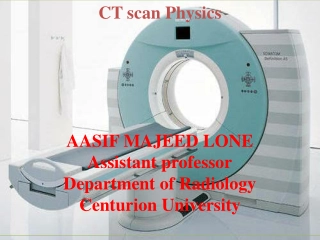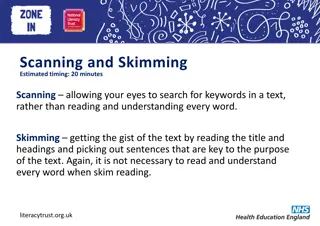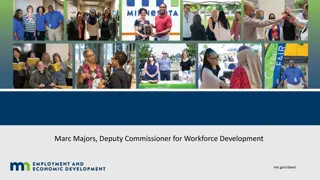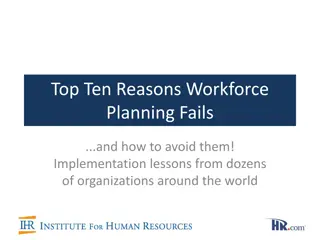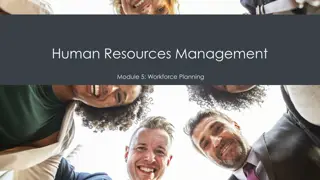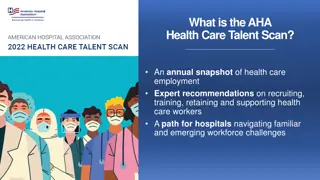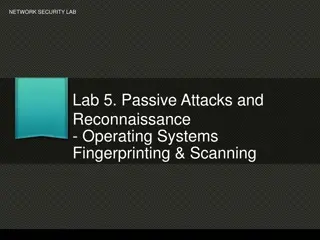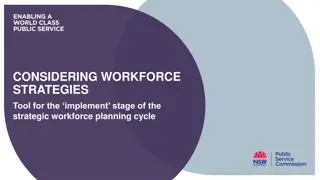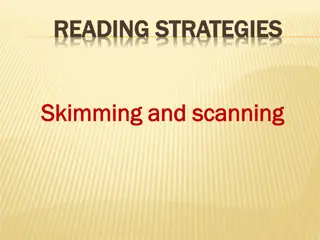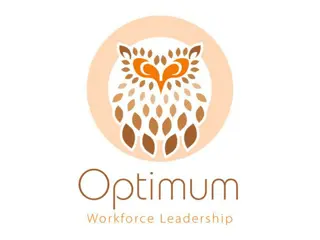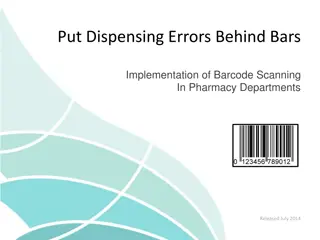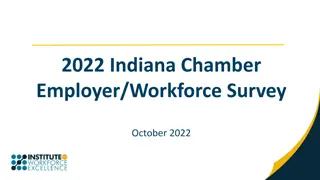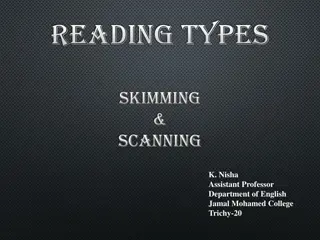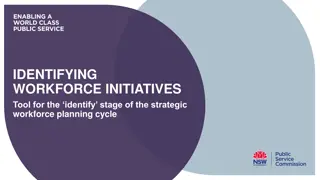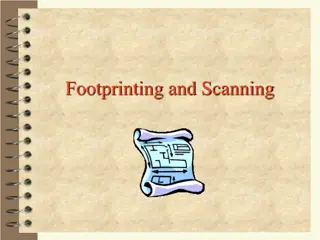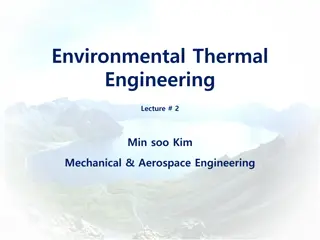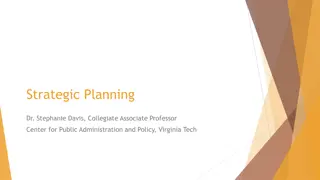Environmental Scanning Tool for Strategic Workforce Planning Cycle
In the Compare stage of strategic workforce planning, utilizing the Environmental Scanning Tool can assist in identifying work and workforce scenarios to achieve organizational goals. The tool consists of three templates including Choosing the Right Type of Data, Environmental Scanning Template, and Future Trend Deep Dive Template. These templates help in presenting compelling data to engage stakeholders effectively.
Download Presentation

Please find below an Image/Link to download the presentation.
The content on the website is provided AS IS for your information and personal use only. It may not be sold, licensed, or shared on other websites without obtaining consent from the author. Download presentation by click this link. If you encounter any issues during the download, it is possible that the publisher has removed the file from their server.
E N D
Presentation Transcript
ENVIRONMENTAL SCANNING Tool for the compare stage of the strategic workforce planning cycle
Please note: There are three templates within this tool: 1) Choosing the right type of data 2) Environmental scanning template 3) Future trend deep dive template This is not a comprehensive tool for the Compare stage of the Strategic Workforce Planning cycle. These templates will assist you with certain aspects of the Compare stage. To learn about all the aspects of the Compare Stage, register for the NSW Government Strategic Workforce Planning Masterclasses Goal of the Compare stage Identify different work and workforce scenarios to deliver organisational goals and the estimated cost of each scenario. Please note that you may not need to use all elements of this tool. You may tailor or modify the templates based on the needs and strategic workforce planning maturity of your organisation. Additional information If you need further information or would like to provide feedback, please contact the NSW Public Service Commission at swp@psc.nsw.gov.au 2
1) Choosing the right type of data and information Workforce data can be presented in a variety of ways depending on the story you want to tell. As you build your case for change there are a range of considerations you need to think through to make sure you present a strong, evidenced based argument. The questions that will be on your mind include: What is the data and information I need to help me engage and persuade the stakeholder? Tips on how to use this tool How can I present the data and information in a way that is compelling and enables me to have the conversations I need to have? Don t be limited by the data and information you do or do not have. If you are constrained by a lack of sufficient or accurate data, think creatively about how you can use what you already have, to tell the story This tool can help you answer the above questions to effectively present your data. It s important to remember you don t need perfect data before you start strategic workforce planning Assess what type of data you need to effectively identify current and future workforce requirements Use workforce data and information to build insights and support your conversations with senior stakeholders 3
1) Choosing the right type of data Firstly, it is important to identify what type of workforce data you need using the spectrum provided below. 1 Analytics/ Research Reporting Purpose: To provide an update on progress using data or information Outcome: Endorsement to proceed and/or secure more funding Purpose: To provide workforce insights to open up a conversation Outcome: Agree to support initiatives, implementation and/or action plan Secondly, based on your response to the question above, consider what types of data will support the outcome you re trying to achieve. 2 Type of data Descriptive Diagnostic Predictive Prescriptive Focus Hindsight Insight Foresight Simulation Description of what it will tell What happened What made it happen What will happen What should we do Input: Information Output: Knowledge Input: Knowledge Output: Understanding Input: Understanding Output: Forecast Input: Forecast Output: Optimisation Outcome it achieves How it is represented Method: Graphical Method: Statistical Method: Algorithm Method: Model List the pros and cons of the type of data you think will best support the outcomes you re trying to achieve.
2) Environmental scanning In the Compare Stage of the Strategic Workforce Planning cycle, it can be helpful to use environmental scanning to understand the different trends occurring at the macro level that may impact your organisation s work and workforce requirements. The template below helps you to identify macro trends using the DEGEST model, by identifying Demographic, Economic, Government and Policy, Environmental, Social and Cultural, and Technological factors that may impact your workforce. The next page provides examples to help you get started. Note that there are other environmental scanning models such as the PESTLE model. Tips on how to use this tool Environmental scanning works better in groups. Organise a workshop with relevant stakeholders across the business Challenge yourself to think about how much the world might change in the future, by first thinking about how different the world was 10 years ago Think about the scale of impact and certainty each trend might have on your organisation 5
Environmental scanning template The tool below helps you identify trends occurring at the macro level and assess its impact and certainty. The tool below has been grouped using the DEGEST model, which is done as part of the scanning component of the Compare Stage. Scale of impact refers to the impact the trend may have on your organisation, work and workforcenvironmentale. Certainty refers to how certain we can be of the impact the trend may have on your agency and timeframe refers to the peak impact of this trend. Scale of impact (High, Medium, Low) Certainty (High, Medium, Low) Timeframe Identified trend High High 10 years Demographic Example: Ageing population High Low 8 years Economic Example: Unemployment rate significantly reduced Medium Medium 7 years Government and Policy Example: Bottom up policies High Medium 5 years Environmental Example: Accelerated species extinction due to climate change High Low 3 years Social and Cultural Example: Increased nationalism and decreased globalisation High Low 2 years Technological Example: Significant increase in use of blockchain 6
3) Future trend deep dive This exercise helps remove some of the guess work involved in strategic workforce planning and explores future workforce risks and opportunities. After you ve completed environmental scanning and identified trends at the macro level, do a deep dive into trends that are likely to have the high impact and low certainty and choose a trend that is likely to happen in 3 or more years' time. The tool below helps you deep dive into plausible future trends. Tips on how to use this tool Choose future trends that are high impact and low certainty, and likely to happen in 3 or more years time When exploring trends make sure you do your research to better understand the trends and their potential implications on your workforce This exercise works better in groups. Plan a workshop with relevant stakeholders across the business Don t worry yet about how you will make these changes that comes later in the SWP process. The most important thing at this stage is to assess the impact of plausible future trends 7
Future trend deep dive template The tool below helps you consider what the future trend is, what the impacts might be on your organisation, and what this might mean for future workforce requirements. Outline the name of the trend with the highest impact and lowest certainty occurring greater than 3 years' time List your sources (you can refer to news articles, government, industry and research publications) Describe this trend in detail* What are the features of this trend? List 5- 10 dot points Is there strong evidence and accounts of this trend? *Note: You may list more than one trend Possible impacts on our organisation How might this trend change the work we do? Will our culture need to change as a response to these emerging trends? Workforce requirements What will our workforce need to look like to be ready for the impacts of this trend? What capabilities might we need? What operating model might we need? What new partnerships could we form? 8
Resources For more information about scenario planning, please refer to these resources: Alex Hagan (2019), Thriving in Complexity, Chapter 11, pages 142-161 Office of Personnel Management - Scenario Based Workforce Planning For more inspiration on the Compare stage of the Strategic Workforce Planning cycle, listen to the following recordings from the SWP Accelerator Workshop Series: The New Workforce with Ben Hamer, Adjunct Professor Centre for the New Workforce Swinburne University Telling the Story with Jennifer Dobell, National Manager of Workforce Strategy at Services Australia Join our Workforce Planning LinkedIn Group Join our LinkedIn group Strategic Workforce Planning Community NSW Government Text Description automatically generated Register for our NSW Government Strategic Workforce Planning Masterclass 9


